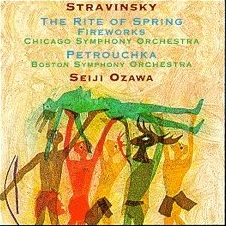 Stravinsky’s Rite of Spring, also commonly referred to by its original French title, “Le Sacre du Printemps†is a ballet piece that was commissioned by Les Ballet Russe maestro Serge Diaghilev. The music’s innovative complex rhythmic structures, timbres, and use of dissonance have made it a seminal 20th century composition. Premiered at the Theatre des Champs-Elysee in Paris in May 1913, the premiere involved one of the most famous classical music riots in history. The intensely rhythmic score and primitive scenario shocked audiences more accustomed to the demure conventions of classical ballet, and the audience went on the rampage. Composer and conductor Leonard Bernstein has said of one passage, “That page is sixty years old, but it’s never been topped for sophisticated handling of primitive rhythms…”, and of the work as a whole, “…it’s also got the best dissonances anyone ever thought upâ€.
Stravinsky’s Rite of Spring, also commonly referred to by its original French title, “Le Sacre du Printemps†is a ballet piece that was commissioned by Les Ballet Russe maestro Serge Diaghilev. The music’s innovative complex rhythmic structures, timbres, and use of dissonance have made it a seminal 20th century composition. Premiered at the Theatre des Champs-Elysee in Paris in May 1913, the premiere involved one of the most famous classical music riots in history. The intensely rhythmic score and primitive scenario shocked audiences more accustomed to the demure conventions of classical ballet, and the audience went on the rampage. Composer and conductor Leonard Bernstein has said of one passage, “That page is sixty years old, but it’s never been topped for sophisticated handling of primitive rhythms…”, and of the work as a whole, “…it’s also got the best dissonances anyone ever thought upâ€.
Certainly the piece is provocative. It tells of a primal ritual in which, to satisfy the Gods of Spring, a young girl is chosen to literally dance herself to death. In doing so, Stravinsky utilized the Orchestra to sound as if the very earth was coming alive in its awakening from Winter. That very Russian concept, of course is key to the piece, and the orchestra produces shudders and groans just as what Stravinsky described as ‘The violence of Spring†– ice cracking, earth melting, branches groaning all portrayed. Nice and tuneful it is not. A performance of the work lasts about 33 minutes, and if one can imagine the sounds of nature shuddering after a long Russian winter, then the Rite of Spring hits the topic perfectly. It is avant garde even today, but a more apt musical description of spring has yet to be written. And anyone who can incite an entire audience to riot in a classical ballet premiere just has to be listened to.